HCG may refer to:
- Historic Centre of Guimarães, a UNESCO World Heritage Site
- Hickson Compact Group
- Hellenic Coast Guard
- Honoris Crux Gold, of the Republic of South Africa
- Hoppers Crossing railway station, Melbourne
- Human chorionic gonadotropin (hCG)
HCG may refer to:
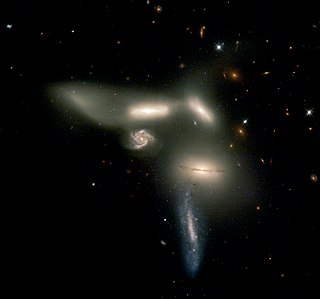
Seyfert's Sextet is a group of galaxies about 190 million light-years away in the constellation Serpens. The group appears to contain six members, but one of the galaxies, NGC 6027d, is a background object and another "galaxy," NGC 6027e, is actually a part of the tail from galaxy NGC 6027. The gravitational interaction among these galaxies should continue for hundreds of millions of years. Ultimately, the galaxies will merge to form a single giant elliptical galaxy.

Human chorionic gonadotropin (hCG) is a hormone for the maternal recognition of pregnancy produced by trophoblast cells that are surrounding a growing embryo, which eventually forms the placenta after implantation. The presence of hCG is detected in some pregnancy tests. Some cancerous tumors produce this hormone; therefore, elevated levels measured when the patient is not pregnant may lead to a cancer diagnosis and, if high enough, paraneoplastic syndromes, however, it is unknown whether this production is a contributing cause or an effect of carcinogenesis. The pituitary analog of hCG, known as luteinizing hormone (LH), is produced in the pituitary gland of males and females of all ages.

HCG 87 is a compact group of galaxies listed in the Hickson Compact Group Catalogue. This group is about 400 million light-years away in the constellation Capricornus. The group distinguishes itself as one of the most compact groups of galaxies, hosting two active galactic nuclei and a starburst among its three members, all of which show signs of interaction. This interaction, which astronomers have called visually, and scientifically, intriguing is being examined to understand the influence of active nuclei on star formation histories.
Elijah Martindale was an American pioneer and a leader of the Restoration Movement in Indiana. He was often called "Elder Elijah Martindale".
A Hickson Compact Group is a collection of galaxies designated as published by Paul Hickson in 1982.

The Honoris Crux Gold, post-nominal letters HCG, is a South African military decoration for bravery which was instituted in 1975. It was awarded to members of the South African Defence Force for outstanding acts of bravery while in extreme danger. It was the second most senior in a set of four classes of Honoris Crux decorations which replaced the discontinued Honoris Crux of 1952.

The Weight Loss Cure "They" Don't Want You to Know About is a weight loss book written by salesman and convicted fraudster Kevin Trudeau. It was released in April 2007 by Alliance Publishing.
Gravindex is an agglutination inhibition test performed on a urine sample to detect pregnancy. It is based on double antigen antibody reaction. The test detects the prevention of agglutination of HCG-coated latex particles by HCG present in the urine of pregnant women.

Thomas Van der Plaetsen is a Belgian decathlete. His biggest achievements are winning the gold medal for decathlon at the 2016 European Athletics Championships, winning bronze medal for heptathlon at the 2014 World Indoor Championships, and gold medal for decathlon at the 2013 and 2015 Summer Universiade.
Induction of final maturation of oocytes is a procedure that is usually performed as part of controlled ovarian hyperstimulation to render the oocytes fully developed and thereby resulting in optimal pregnancy chances. It is basically a replacement for the luteinizing hormone (LH) surge whose effects include final maturation in natural menstrual cycles.
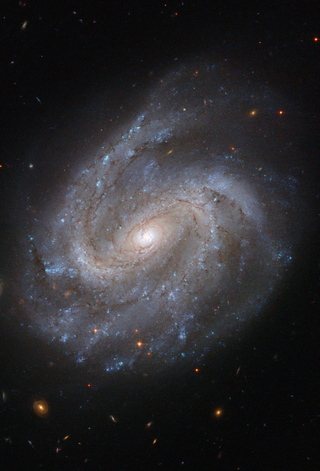
NGC 201 is a spiral galaxy in the constellation of Cetus. It is one of the group members of HCG 7, with the other group members NGC 192, NGC 196, and NGC 197. It was discovered on December 28, 1790 by William Herschel.
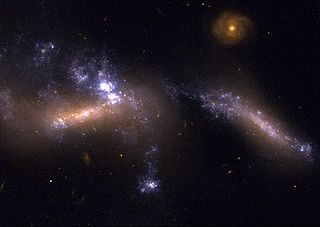
NGC 1741 is a distant pair of interacting galaxies in the Eridanus constellation. It was discovered on 6 January 1878 by French astronomer Édouard Stephan. As a result of the collision, the galaxies are in a rapid starburst phase. The galaxies are classed as Wolf–Rayet galaxies due to their high content of rare Wolf–Rayet stars.

NGC 1190 is a lenticular galaxy approximately 109 million light-years away from Earth in the constellation of Eridanus. It was discovered by American astronomer Francis Leavenworth on December 2, 1885 with the 26" refractor at Leander McCormick Observatory.
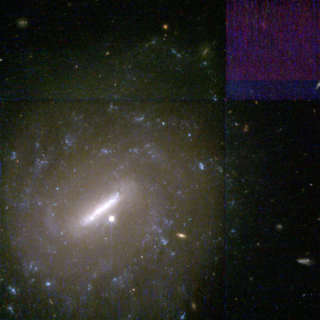
NGC 1189 is a barred spiral galaxy approximately 105 million light-years away from Earth in the constellation of Eridanus. It was discovered by American astronomer Francis Leavenworth on December 2, 1885 with the 26" refractor at Leander McCormick Observatory.

NGC 1191 is a lenticular galaxy approximately 406 million light-years away from Earth in the constellation of Eridanus. It was discovered by American astronomer Francis Leavenworth on December 2, 1885 with the 26" refractor at Leander McCormick Observatory.

NGC 1199 is an elliptical galaxy approximately 107 million light-years away from Earth in the constellation of Eridanus. It was discovered by William Herschel on December 30, 1785.

NGC 1192 is a lenticular galaxy approximately 417 million light-years away from Earth in the constellation of Eridanus. It was discovered by American astronomer Francis Leavenworth on December 2, 1885 with the 26" refractor at Leander McCormick Observatory.

B S Ajai Kumar is an Indian oncologist and entrepreneur. He is the founder and executive chairman of HealthCare Global Enterprises Ltd, a South Asian provider of cancer care.
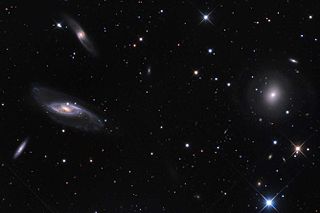
NGC 542 is a spiral galaxy in the constellation Andromeda, which is approximately 215 million light years from the Milky Way. Together with the galaxies NGC 529, NGC 531, and NGC 536, it forms the Hickson Compact Group 10, abbreviated HCG 10. It was discovered by Irish astronomer R.J. Mitchell in 1885.

NGC 5910 is an elliptical galaxy located about 540 million light-years away in the constellation Serpens. It was discovered by astronomer William Hershel on April 13, 1785. NGC 5910 is also a strong radio source with a conspicuous nuclear jet.